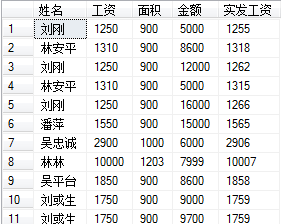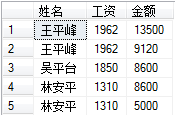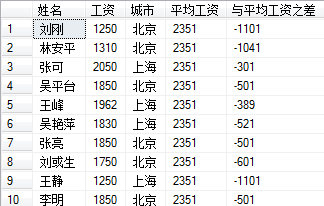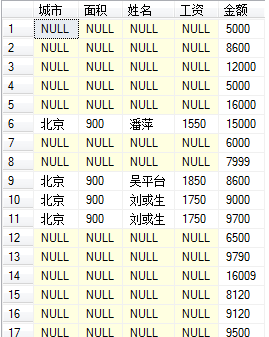- use db_sqlserver2
- select 姓名, 工资, 面积, 金额, (工资+金额/1000) as 实发工资 from 职工,仓库, 订购单
- where 职工.职工号=订购单.职工号 and 职工.仓库号=仓库.仓库号

2:
- select 姓名,工资,金额 from 职工,订购单 where 姓名 like '%平%' and 职工.职工号 = 订购单.职工号 order by 工资 desc
3:
- select 姓名,工资,金额 from 职工,订购单 where 姓名 like '%平%' and 职工.职工号 = 订购单.职工号 order by 工资 desc, 金额 desc

4:
- select 姓名, 工资, 城市, (select AVG(工资) from 职工) as 平均工资 , (工资-(select AVG(工资) from 职工)) as 与平均工资之差
- from 职工, 仓库 where 仓库.仓库号=职工.仓库号

5:带保存功能的多表连接查询
在SQL语句中,利用into语句可以把查询到的结果保存成一张新表,然后再对新表进行数据信息查询。
- select 仓库.仓库号, 城市, 面积, 姓名, 工资, 金额 into 多表连接产生的新表 from 仓库, 职工, 订购单
- where 仓库.仓库号=职工.仓库号 and 职工.职工号=订购单.职工号
- select * from 多表连接产生的新表

//查看不同仓库中的所有职工的仓库号、平均销售金额、最大销售金额、最小销售金额、最大销售金额与最小销售金额之差的信息
- select 仓库号, AVG(金额) as 平均销售金额, MAX(金额) as 最大销售金额, MIN(金额) as 最小销售金额,
- (MAX(金额) - MIN(金额)) as 最大金额与最小金额之差 from 多表连接产生的新表 group by 仓库号;

可以把分组查询结果再生成一张新表
- select 仓库号, AVG(金额) as 平均销售金额, MAX(金额) as 最大销售金额, MIN(金额) as 最小销售金额,
- (MAX(金额) - MIN(金额)) as 最大金额与最小金额之差 into 分组查询产生的新表
- from 多表连接产生的新表 group by 仓库号;
- select * from 分组查询产生的新表
6: 内连接查询(inner join)
使用比较运算符对表之间的某些数据进行比较,并列出这些表中与连接条件相匹配的数据行。
- select 姓名, 城市 from 仓库 inner join 职工 on 职工.仓库号=仓库.仓库号
多表的内连接查询
- select 城市,面积, 姓名, 工资, 金额 from 仓库
- inner join 职工 on 职工.仓库号=仓库.仓库号
- inner join 订购单 on 职工.职工号=订购单.职工号
- and 工资>1800 and 面积<1000 and 金额 != 16600
7:左连接查询(left join)
除满足连接条件的记录显示外,第一张表中不满足条件的记录也显示在结果集中。
- select 姓名, 城市 from 仓库
- left join 职工 on 职工.仓库号=仓库.仓库号 and 城市 is not null and 姓名 like '%王%'

- select 城市, 面积, 姓名, 工资, 金额 from 仓库
- left join 职工 on 职工.仓库号 = 仓库.仓库号
- left join 订购单 on 职工.职工号=订购单.职工号
- and 工资>1800 and 面积<1000 and 金额!=16600

在第一个left join左连接中,第一张表是仓库表,第二张表是职工表,在第二个left join左连接中,第一张表是职工表,第二张表是订购单表
8:右连接查询
除满足连接条件的记录显示外,第二张表中不满足条件的记录也显示在查询结果集中
- select 姓名, 城市 from 仓库
- right join 职工 on 职工.仓库号=仓库.仓库号 where 城市 is not null and 姓名 like '%王%'

- select 城市, 面积, 姓名, 工资, 金额 from 仓库
- right join 职工 on 职工.仓库号=仓库.仓库号
- right join 订购单 on 职工.职工号=订购单.职工号
- and 工资>1500 and 面积<1000 and 金额!=16600

- select 城市, 面积, 姓名, 工资, 金额 from 仓库
- right join 职工 on 职工.仓库号=仓库.仓库号
- right join 订购单 on 职工.职工号=订购单.职工号
- <span style="color:#ff0000;">where</span> 工资>1500 and 面积<1000 and 金额!=16600
把and关键字换为where关键字后的效果图,会发现那些无用的数据没有了

9:全连接查询
除满足连接条件的记录显示外,两张表中的不能满足条件的记录也显示在查询结果集中
- select 姓名,城市 from 仓库 full join 职工 on 职工.仓库号=仓库.仓库号 and 城市 is not null and
- 姓名 like '%王%';

集合的交、并、差运算查询
为了进行并、交、差运算,要求运算的两个查询结果具有相同的字段个数,并且对应的字段的值要出自同一个值域,即具有相同的数据类型和取值范围
10:并运算(union)
主要将两个或者更多个查询的结果组合为单个结果集,该结果集包含联合查询中的全部查询的全部行
- select 仓库号 from 仓库 where 城市='北京'
- union
- select 仓库号 from 职工 where 工资>2000
- select 仓库号 from 仓库 where 城市='北京'
- union
- select 仓库号 from 职工 where 工资>2000
- select distinct 仓库.仓库号 from 仓库, 职工 where 仓库.仓库号=职工.仓库号 and (城市='北京' or 工资>2000)
使用union all 保留重复行
- select 仓库号 from 仓库 where 城市='北京'
- union all
- select 仓库号 from 职工 where 工资>2000

11:交运算(intersect)
可以将两个select语句的查询结果通过交运算合并成一个查询结果
- select 仓库号 from 仓库 where 城市='北京'
- intersect
- select 仓库号 from 职工 where 工资>2000
- select distinct 仓库.仓库号 from 仓库, 职工 where 城市='北京' and 仓库.仓库号=职工.仓库号 and 工资>2000

12:差运算(except)
可以计算两个select查询结果之间的数据差,即返回在一个查询结果中存在,但在另一个查询结果中不存在的所有行。
- select 仓库号 from 仓库 where 城市='北京'
- except
- select 仓库号 from 职工 where 工资>2900
- select 仓库号 from 仓库 where 城市='北京' and 仓库号 not in(select 仓库号 from 职工 where 工资>2900)
